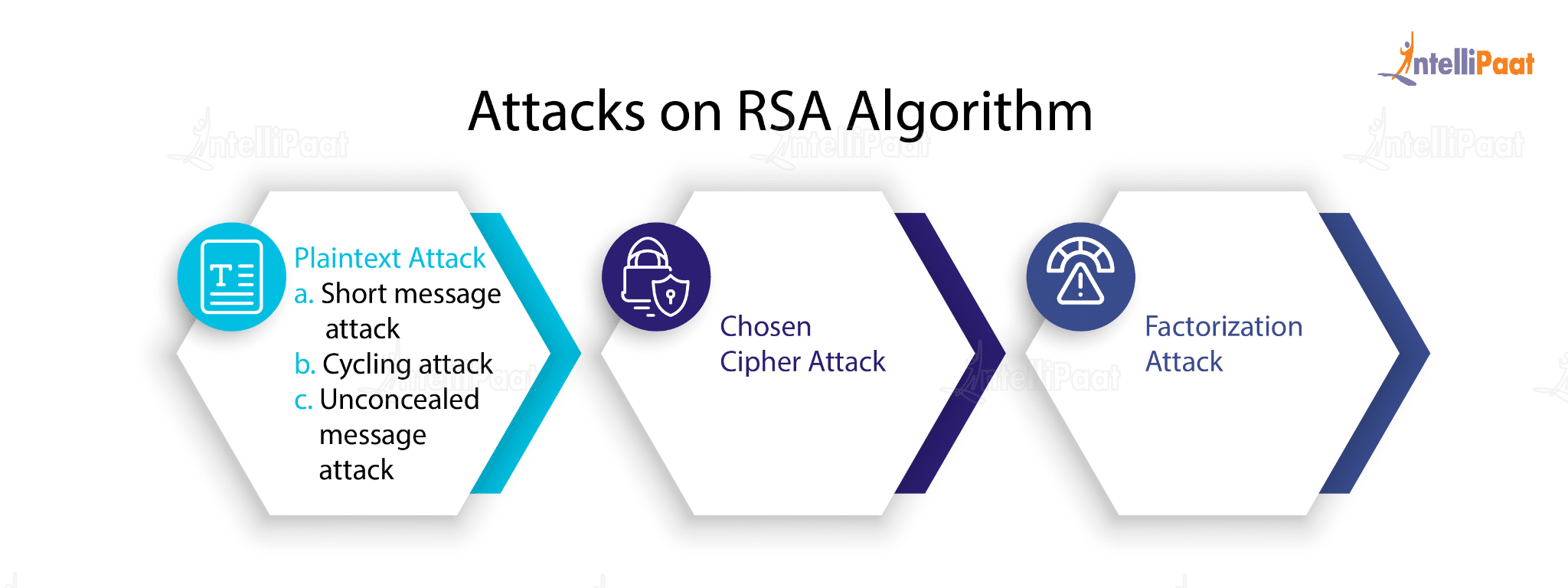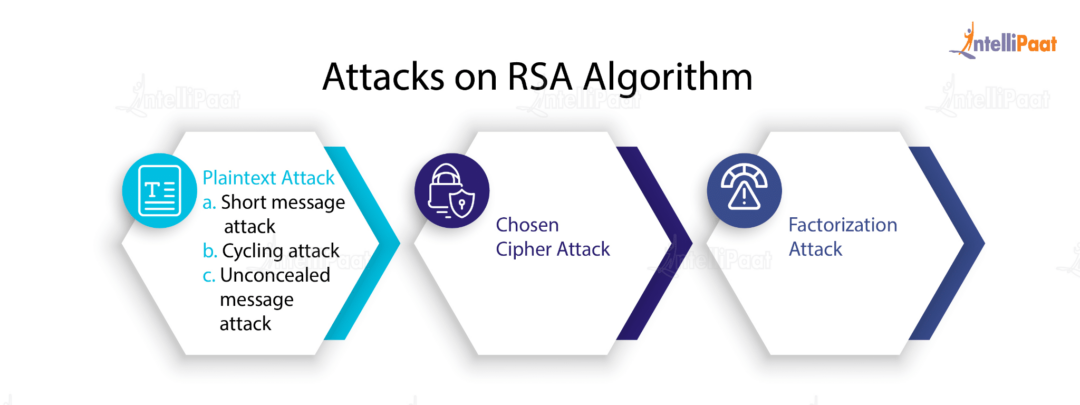What is RSA Algorithm?
Let’s look at the topics we’ll be discussing in this blog:
- What is RSA Algorithm?
- RSA Encryption Algorithm
- RSA Algorithm Example
- Application of RSA Algorithm
- Possible Attacks on RSA Algorithm
- Difference Between AES and RSA Algorithm
- Advantages of RSA Algorithm Over Other Algorithms
- Conclusion
Check out our youtube video on Cyber Security Full Course:
What is RSA Algorithm?
RSA Algorithm’s full form is Rivest Shamir Adleman. It was introduced in 1978 by Rivest, Shamir, Adleman as an asymmetric encryption algorithm. There are both public and private keys involved in this algorithm. RSA Algorithm in cryptography is based on the fact that you can find and multiply large numbers easily but finding the factor of their product is difficult.
Mathematical research estimates that if the key value is 100 digits, it would take attackers more than 70 years to find its value. The most difficult part of the algorithm probably is choosing and generating the public and private keys.
Check out this Cyber Security Tutorial!
RSA Encryption Algorithm
In the RSA Encryption Algorithm, a public key is used for encryption and a private key, different from the public key and only known to the recipient, is used for decryption. The public key would be the product of two large prime numbers. That product is made public. The decryption would require knowledge of the two prime factors of that number and there is no known method to find the prime factors of such numbers. This means that only the person who created the public key will be able to generate the private key as well.
Let’s look at the RSA Algorithm Steps:
- You can choose any two large prime numbers, say A and B.
- Next, you can find the product of A and B, say N.
N = A*B - You have to select a public key, say E, for encryption. You have to make sure this key isn’t a factor of (A-1) and (B-1).
- Now you can select the private key for decryption say, D. The private key should match this equation:
(D*E) mod (A-1)*(B-1) = 1 - You can calculate the ciphertext from the plaintext using this equation:
Ciphertext = Plaintext^E mod N - Once the ciphertext is generated, it should be sent to the recipient.
- You can decrypt the plaintext from the ciphertext using this equation:
Plaintext = Ciphertext^D mod N
Check out our PG Program in Cyber Security!
RSA Algorithm Example
For this example, let’s try and work the RSA Encryption Algorithm with random prime numbers, say 7 and 17. So,
A = 7, and B = 17 N = A*B N = 7*17 N = 119 Now, we have to select a public key, say p, so that isn’t a factor of (A-1) and (B-1). (7-1)*(17-1) = 6*16 = 96 Now, the factor of 96 is 2*2*2*2*2*3. So, we can choose our public key, E as 5 since it isn’t a factor of 2 or 3. Now, to select the private key, we have to make sure it matches this equation: (D*E) mod (A-1)*(B-1) = 1 (D*5) mod (6)*(16) = 1 (D*5) mod 96 = 1 Now, we can choose D as 77 to satisfy the equation. (77*5) mod 96 = 1 385 mod 96 = 1 1 = 1 It satisfies the equation so we can move on. Now, we have to calculate the ciphertext. Let’s take our plaintext to be 10. Ciphertext = Plaintext^E mod N Ciphertext = 10^5 mod 119 Ciphertext = 40 Once, we have the ciphertext we can send it to the recipient. We can also check the value by decrypting it with the equation: Plaintext = Ciphertext^D mod N Plaintext = 40^77 mod 119 Plaintext = 10
That is the plaintext we chose.
Preparing for a job Interview? Check out our blog on Cyber Security Interview Questions!
Application of RSA Algorithm
Let’s look at some applications of the RSA Algorithm:
- RSA Algorithm is used in hybrid encryption.
- RSA Algorithm is also used in digital signatures.
Want to become an expert in Cyber Security? Enroll in our Cyber Security course today!
Possible Attacks on RSA Algorithm

Here’s a list of the possible attacks on the RSA Algorithm:
- Plaintext Attack – There can be three types of Plaintext Attacks:
- Short message attack – In short message attacks, it is generally assumed that the attacker already knows some of the plaintext messages. Now, if an attacker knows some blocks of plaintext, they could try to encrypt the blocks using the information. Padding bits of encryption is used to prevent a short message attack.
- Cycling attack – The reverse process takes place in a cycling attack. The attacker assumes some permutations for the ciphertext. If this assumption is true, they can try and reverse the process to generate the plaintext using the ciphertext.
- Unconcealed message attack – There are some rare times when, for some reason, the encrypted ciphertext is the same as the plaintext. The plaintext isn’t concealed and this type of attack is called an unconcealed message attack.
- Chosen cipher Attack – In a chosen cipher attack, the attacker finds out the plaintext from the ciphertext using the extended Euclidean algorithm.
- Factorization Attack – In a factorization attack, the attacker can impersonate the owners of the key. They can use the information to decrypt sensitive data bypassing the system’s security. The attackers aim at an RSA cryptographic library. This library is used to generate the RSA key. This gives the attackers access to private keys of various security tokens, Motherboard Chipsets, and smartcards because they have the target’s public key.
If you have any doubts? Drop it on our Cyber Security Community page!
Difference Between AES and RSA Algorithm
Let’s look at the differences between the AES and RES Algorithms:
| Parameters | RSA | AES |
| Encryption | Slower | Faster |
| Decryption | Slower | Faster |
| Power Consumption | Low | High |
| Algorithm | Symmetric | Asymmetric |
| Security | Least secured | Well secured |
| Rounds | 1 | 10/12/14 |
| Hardware & Software Implementation | Not efficient | Faster |
| Ciphering & Deciphering Algorithm | Different | Same |
Learn more about the RSA Algorithm in our Cyber Security and Ethical Hacking Course! Enroll today!
Advantages of RSA Algorithm over other Algorithms
There are some advantages of the RSA Algorithm over other algorithms. Here are some of them:
- RSA Algorithm is very easy to implement.
- Confidential data can be transmitted safely and securely using RSA Algorithm.
- RSA Algorithm involves a lot of complex mathematics which makes it more difficult to crack.
- You can easily share the public key with users.
Conclusion
We have discussed the Rivest Shamir Adleman Algorithm in this blog. We have talked about how the algorithm works along with examples. We also know why the RSA Algorithm is more advantageous over other algorithms.
Are you tempted by the field of Cyber Security? Enroll in Cyber Security Master’s Program today!
The post What is RSA Algorithm? appeared first on Intellipaat Blog.
Blog: Intellipaat - Blog
Leave a Comment
You must be logged in to post a comment.









